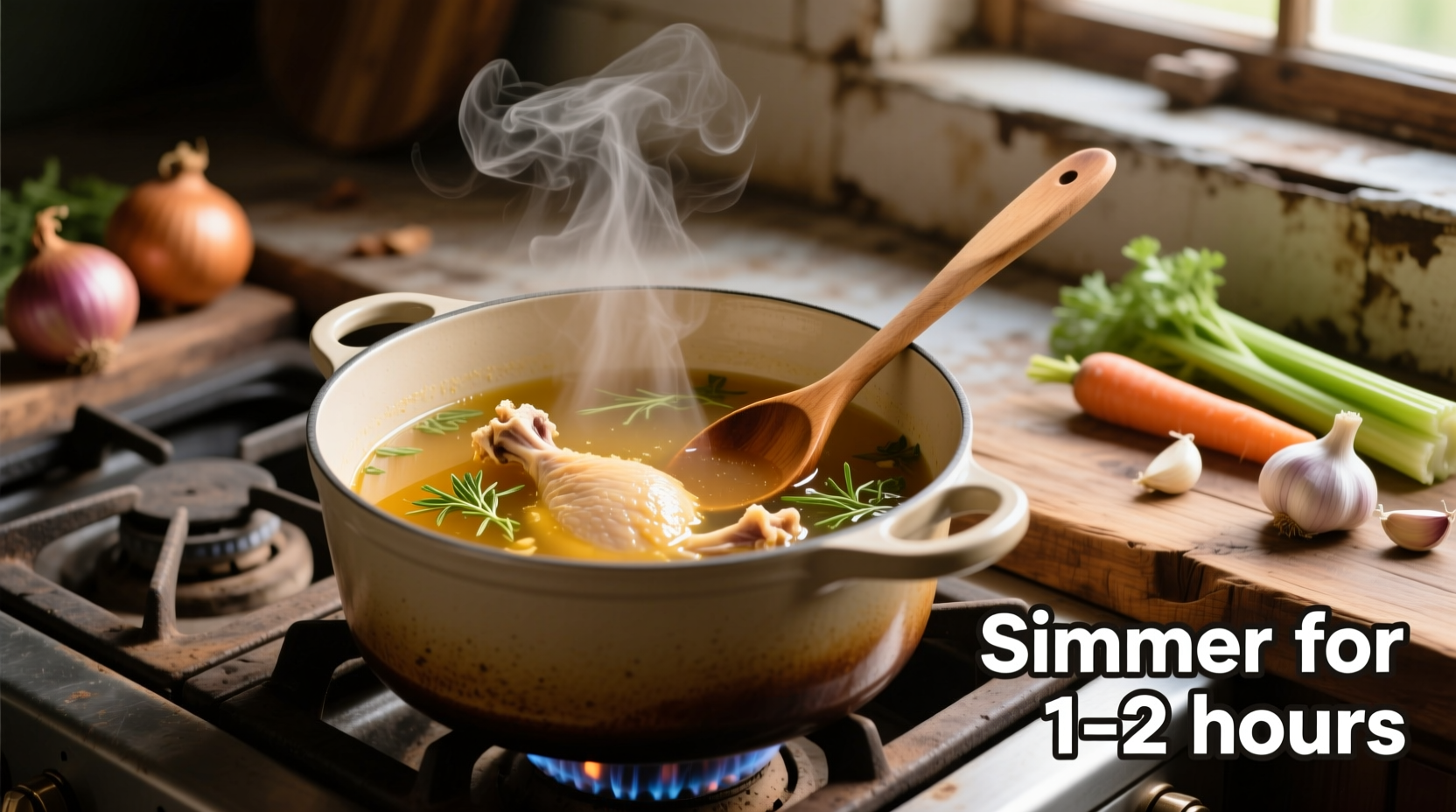Discover the precise timing and techniques professional chefs use to create crystal-clear, nutrient-rich chicken broth. Whether you're making a quick weeknight stock or slow-simmered bone broth, understanding the science behind cooking duration transforms ordinary broth into extraordinary foundation for soups, sauces, and risottos.
The Science Behind Broth Simmering Time
Proper simmering duration directly impacts flavor depth, nutritional value, and safety. According to USDA food safety guidelines, poultry must reach 165°F to eliminate pathogens, but broth requires sustained heat to extract collagen and nutrients from bones.
| Cooking Stage | Time Frame | Key Processes |
|---|---|---|
| Initial Simmer | 0-30 minutes | Protein coagulation, impurity removal |
| Flavor Extraction | 1-3 hours | Collagen conversion to gelatin, aromatic development |
| Full Maturation | 3-4 hours | Complete flavor integration, optimal clarity |
| Bone Broth Phase | 10-12 hours | Mineral extraction, maximum gelatin yield |
Step-by-Step Cooking Timeline
Preparation Phase (15 minutes)
Start with cold water covering bones by 2 inches. Add 2 tablespoons apple cider vinegar to help extract minerals. Never skip skimming the initial foam—this ensures crystal-clear broth. As culinary expert Harold McGee explains in On Food and Cooking, "the scum consists of denatured proteins that will make your broth cloudy and slightly off-flavored if not removed."
Gentle Simmer Phase (3-4 hours)
Maintain a bare simmer where only occasional bubbles break the surface. Higher temperatures cause fat emulsification and cloudiness. This slow extraction process converts collagen to gelatin, creating that luxurious mouthfeel. Professional kitchens use a chinois (conical sieve) to monitor bubble activity—your broth should barely disturb the sieve's surface.

Critical Timing Factors
Your exact cooking duration depends on several variables:
- Equipment: Stockpots maintain temperature better than thin-walled pots. Dutch ovens require 15% less time due to superior heat retention
- Bone Type: Knuckle bones need 4+ hours while backs require only 3 hours for full extraction
- Desired Intensity: Restaurant-grade demi-glace requires 8-10 hours of reduction
- Safety Considerations: Never leave broth unattended during initial heating phase
Avoiding Common Timing Mistakes
Many home cooks make these critical errors:
Under-Simmering (Less than 2.5 hours)
Results in weak flavor and watery texture. The collagen hasn't fully converted to gelatin—your broth won't gel when chilled. This happens frequently when using pressure cookers without proper timing adjustments.
Over-Boiling (Vigorous bubbling)
Causes emulsification of fats and proteins, creating cloudy, greasy broth. As noted in The Professional Chef by the Culinary Institute of America, "a rolling boil breaks down the delicate flavor compounds and extracts bitter elements from bones."
Extended Cooking Without Monitoring
After 4 hours, evaporation significantly concentrates flavors. Check liquid levels hourly and add hot water as needed. Bone broth enthusiasts often make the mistake of cooking beyond 12 hours, which can develop off-flavors from over-extracted minerals.
When Your Broth Is Perfectly Done
Look for these visual and textural indicators:
- Gel Test: Chilled broth should have a wobble like firm Jell-O
- Clarity: You should clearly see the bottom of your container
- Color: Rich golden-amber, not pale yellow or dark brown
- Texture: Coats the back of a spoon without being viscous
Professional chefs perform the "spoon stand test"—when a wooden spoon stands upright in the cooled broth, you've achieved proper gelatin concentration. This indicates complete collagen conversion, typically occurring at the 3.5-hour mark for standard chicken broth.
Storage and Usage Guidelines
Properly cooked broth maintains quality for:
- Refrigeration: 5-7 days (store with 1/2 inch fat cap for best preservation)
- Freezing: 6-12 months (use ice cube trays for portion control)
- Pressure Canning: 18-24 months (requires proper canning procedures)
Remember that reheating broth to 165°F for 1 minute refreshes flavors while maintaining safety. For best results, reduce broth by 50% to create instant demi-glace for sauces.
Troubleshooting Timing Issues
Encountering problems with your broth? Try these solutions:
- Cloudy broth: Simmered too vigorously—strain through cheesecloth and avoid boiling next time
- Weak flavor: Undercooked or insufficient bones—simmer 30-60 minutes longer
- Bitter taste: Overcooked or burnt bits—next time maintain lower temperature
- No gel: Not enough connective tissue—add more feet or knuckles next batch
Frequently Asked Questions
Can I cook chicken broth overnight?
Yes, but only with proper equipment. Use a slow cooker on low setting (180-200°F) for 10-12 hours for bone broth. Never leave conventional stovetop broth unattended overnight due to fire risk and evaporation issues. The FDA recommends against leaving food in the "danger zone" (40-140°F) for more than 2 hours.
How do I know when chicken stock is done?
Chicken stock is done when it gels when chilled, has rich golden color, and coats the back of a spoon. The bones should feel soft and somewhat crumbly when pressed. Properly cooked stock reaches maximum flavor extraction at 3-4 hours—beyond this point, flavors may become overly concentrated or develop off-notes.
Why does my chicken broth take so long to cook?
Broth requires extended cooking because collagen conversion to gelatin happens slowly at safe temperatures. The process begins around 160°F but optimal conversion occurs between 180-200°F. Rushing with higher heat creates cloudy, greasy broth. Bone density, cut size, and pot material also affect cooking duration—dense knuckle bones need more time than breast bones.
Can I cook chicken broth for 24 hours?
While possible in specialized equipment, 24-hour cooking typically degrades quality. After 12 hours, mineral extraction can create bitter, metallic flavors. The USDA notes that extended cooking beyond 12 hours provides minimal additional nutritional benefit while increasing the risk of off-flavors. For maximum benefits, 10-12 hours represents the optimal duration for bone broth.
Does boiling chicken broth longer make it better?
No—vigorous boiling creates cloudy, greasy broth with potential off-flavors. The Culinary Institute of America emphasizes that gentle simmering (180-200°F) yields superior results. Extended cooking time only improves broth when maintained at proper temperature. After 4 hours for standard broth or 12 hours for bone broth, additional time provides diminishing returns and may degrade quality.











 浙公网安备
33010002000092号
浙公网安备
33010002000092号 浙B2-20120091-4
浙B2-20120091-4